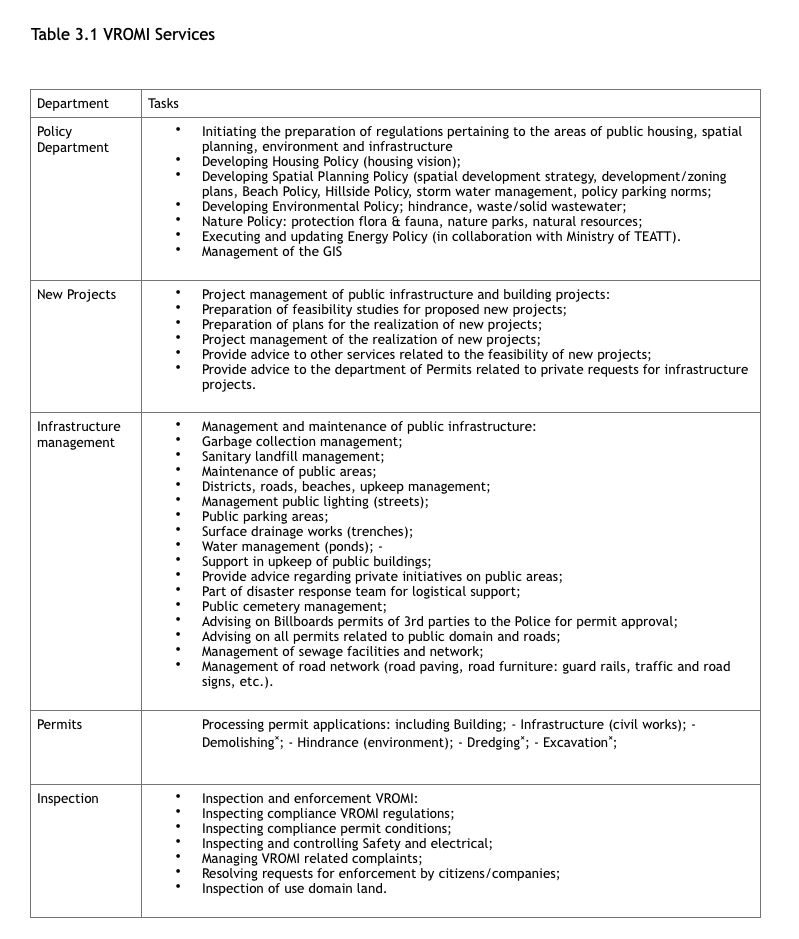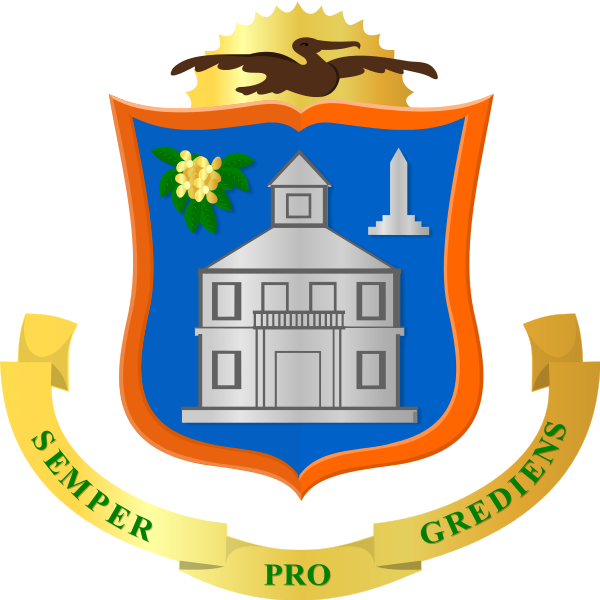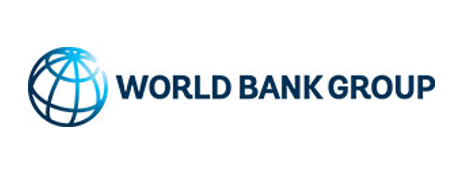Section 3: Governance
INSTITUTIONS AND LEGAL FRAMEWORK
This section summarizes the findings from a review of institutions with roles and responsibilities for managing key services connected to stressors on the environment as well as those having environmental mandates and interests. In sections 1 and 2, discussions provided insight into key services on the island and critical issues associated with degradation to ENR, concerns about human health and pollution, and overall aspects for sustainable development.
Key Institutions and Roles
The overall management, administration and monitoring of environment and social issues of Sint Maarten is assigned to two main Ministries: Ministry of Public Health, Housing, Spatial Planning, Environment and Infrastructure (VROMI,) and the Ministry of Public Health, Social Development and Labor (VSA). The VROMI is the most prominent institution having its hands in environmental matters related to policies, development planning, infrastructure management, and permitting and inspection and enforcement. The roles and associated tasks for each VROMI department are listed in table 3.1. VROMI Services
The tasks and responsibilities of the Ministry of VROMI are defined in the National Ordinance and the Organization Decree Public Housing, Spatial Planning, Environment and Infrastructure. The Ministry of VROMI has four major objectives (as stated in the Ministry Plan-2015- 2018) which are listed below;
- Sustainable development through protection of our environment and natural resources;
- Enhancement of the resilience of the country;
- Enhance the quality of life for citizens;
- Improve the performance and organization of the Ministry.
With these objectives, the VROMI addresses the issues related to environment and nature conservation, as well as controlling in order to safeguard an optimal living, working and recreational environment for the residents of St. Maarten. It is also stated in the Ministry Plan that VROMI can play a role in the protection of the tangible cultural heritage (buildings, monuments, and artifacts) and natural heritage (culturally significant landscapes, and biodiversity).
The Ministry has a broad range of responsibilities that are dispersed across several departments:

The Ministry of Public Health, Social Development and Labor (VSA), is responsible for securing quality health care and developing legislation, guidelines, and policy on the island where the health care system is privately managed. Health care delivery in Sint Maarten operates through primary and secondary health services, through private health care professionals, NGOs, and governmental health care organizations. The Department of Labour Affairs of the VSA is charged with the tasks in the area of labour, including;
- Formulating policy memorandums and recommendations and making proposals for the development, adjustment, monitoring and implementation of a national policy concerning labour and the policy in the area of safety and labour inspection;
- Preparing, implementing and monitoring the national legislation concerning labour and monitoring the compliance with this legislation;
- Promoting international, social and labour affairs, such as the relationship with the International Labour Organization.
There are many other key organizations from public, civil and private sectors, in addition to NGOs, research institutions, and donor institutions who contributes to promotion, advocacy and communication of environmental and social issues in Sint Maarten. These organizations and their key activities are summarized in the interactive Table 3.3: Key Organizations for General Environmental and Social Management Provisions (at the end of the section) and linked to primary responsibilities and activities across the thematic and sector areas discussed in sections 1 and 2.
Sint Maarten Environmental and Social Assessment Management Regulations
Sint Maarten as a part of the Netherlands Antilles within the Kingdom of the Netherlands followed regulations and ordinances of the Kingdom. After dissolution of the Netherlands Antilles, the Island began converting those regulations to national Ordinances and Decrees, with the process still ongoing. The Sint Maarten e-CEA provides an overview for existing laws and regulations, as well as generally accepted good practice objectives for environmental and social assessment management in the below interactive Table 3.2: Key Findings for Key Organizations for General Environmental and Social Management Provisions.
This table focused on nine general environmental and social management provisions that are important for sustainable growth based on good international practices. These provisions are; 1) environmental and social assessment, 2) protection of workers, 3) resource efficiency, pollution prevention and hazardous materials, 4) protection of communities, 5) land acquisition and displacement, 6) biodiversity conservation and protected area management, 7) protection of cultural heritage, 8) financial intermediaries and 9) stakeholder engagement and information disclosure. For each provisions, existing national laws and regulations are examined and gaps are identified. It is recognized that St. Maarten has a limited capacity in terms of staffing within the Ministries to undertake necessary measures for the gaps listed in Table 3.2. While some provisions can easily be handled by the St. Maarten Government, some areas may need additional attention to attain a reasonable set of standards approaching international good practice.
Table 3.2: Key Findings for General Environmental and Social Management Provisions
Click on each tab on the top of the table to learn more about each environmental and social assessment provisions.
|
General Environmental and Social Management Provisions |
|
1. Environmental and Social Assessment |
|
|
2. Protection of Workers. |
|
|
3. Resource Efficiency, Pollution Prevention and Hazardous Materials. |
|
|
4. Protection of Communities. |
|
|
5. Land Acquisition and Displacement. |
|
|
6. Biodiversity Conservation and Protected Area Management. |
|
|
7. Protection of Cultural Heritage. |
|
|
8. Financial Intermediaries (FI). |
|
|
9. Stakeholder Engagement and Information Disclosure. |
|
As discussed in the CEA, the Government of Sint Maarten is engaged in a large-scale program to build back a more resilient island after the hurricanes Irma and Maria (2017). These efforts led by the National Recovery Program Bureau (NRPB) are requiring additional funding and support. Many of these initiatives are directly linked to the goals of sound environmental and social risk assessment and management. During implementation of these recovery projects, environmental, social and health issues will be raised, and they should be carefully assessed and managed. For this purpose, the NRPB will be in a critical role to monitor and supervise the adequate actions taken for general environmental and social management provisions highlighted in table 3.2.
Table 3.3: Key Organizations for General Environmental and Social Management Provisions
To learn more about the key organizations you can navigate this filter tool by selecting the type of the organization you are interested in (either from the public sector, Nogs etc…) and/or the relevant sector where this organization mainly focus its activities (Disaster Risk Management, Tourism, etc..). Each organization will be represented by a box and it’s linked with its website. If you put your mouse on top of it, the key activities of each organization will show up providing more information.

